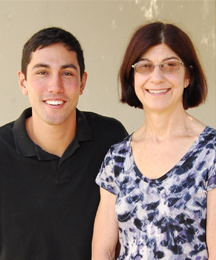Discovery of Biological Energy-Sensing Switch Could Have Broad Implications for Biology and Medicine
Biochemists at The Scripps Research Institute (TSRI) have discovered a genetic sequence that can alter its host gene’s activity in response to cellular energy levels. The scientists have found this particular energy-sensing switch in bacterial genes, which could make it a target for a powerful new class of antibiotics. If similar energy-sensing switches are also identified for human genes, they may be useful for treating metabolism-related disorders such as type 2 diabetes and heart disease.
“This discovery adds a new dimension to our understanding of how cells sense and manage their energy levels, which is one of the most important processes in biology,” said the study’s senior author, Martha J. Fedor, a professor the departments of Chemical Physiology and Molecular Biology and a member of the Skaggs Institute for Chemical Biology at TSRI.
The findings are described online ahead of print on October 21, 2012, in the journal Nature Chemical Biology.
A Fuel Sensor
This type of gene-switching sequence is known as a riboswitch because it appears on the strand of ribonucleic acid (RNA) that is first transcribed from a gene’s DNA. Unlike other known riboswitches, which have relatively limited functions, this one acts as a sensor for the basic molecular fuel that powers all living cells and controls many genes.
The newly discovered riboswitch detects a small molecule known as adenosine triphosphate (ATP), the standard unit of chemical energy in all known organisms on our planet. Scientists had thought that cells use only large and relatively complex proteins to sense these all-important energy molecules and adjust cell activities accordingly. No one had found ATP sensors among riboswitches, which can alter cell activity at a more fundamental level—usually by interrupting a gene’s transcription from DNA.
Moreover, previously described riboswitches are relatively simple feedback sensors that affect narrow metabolic pathways. Most of them merely sense and adjust the expression rate of their own host gene. “This is the first riboswitch that is known to be involved in global metabolic regulation,” said Fedor.
In recent years, the Fedor team had found hints that such a riboswitch could exist. Many RNA sequences with possible riboswitch activity had never been characterized, and several riboswitches in bacteria sense molecules that are closely related to ATP. Fedor and a graduate student in her laboratory, Peter Y. Watson, therefore set out to find bacterial riboswitches that could indeed sense ATP.
Caught in the Act
The task was more challenging than it might have seemed. Watson could not simply expose suspected riboswitches to ATP and see which ones stuck best to the energy molecules. ATP is present in high concentrations in cells, and its interactions with its known protein sensors are necessarily fleeting, low-affinity affairs. Interactions with a riboswitch would be expected to look the same. “Such interactions are really too weak to be detected using traditional methods,” Watson said. But he found evidence that an RNA interaction with an ATP-like molecule would occur in a way that allows the brief coupling to be caught in the act—using a burst of ultraviolet radiation, which can create a strong chemical crosslink between two molecules.
In this way, he discovered a stretch of apparent ATP-binding RNA known as the ydaO motif. Watson performed structure-mapping analyses of ydaO to confirm that it binds to ATP and to determine precisely where it binds. Attaching ydaO to a “reporter” gene, he found that in bacterial cells, the reporter gene’s expression level stayed low when ATP levels were normal and rose sharply when ATP levels dropped—as would be expected if ydaO is really an ATP-sensing riboswitch. Even in unaltered cells of a test bacterium, B. subtilis, levels of the genes that normally contain the ydaO motif rose and fell in the same way in response to changing ATP levels.
The ydaO motif occurs in the large subset of bacteria known as gram-positive bacteria. Across these bacterial species, it has been found, to date, on 580 separate genes. “These ydaO-regulated genes encode proteins that have a wide variety of functions, from cell wall metabolism to amino acid transport,” Watson said. “It makes sense that a riboswitch in control of such disparate processes would be responding to a central metabolite such as ATP.”
New Possibilities
The finding has basic scientific importance because it is the first known example of a riboswitch that binds ATP; it is also the first known riboswitch that has such broad regulatory functions. “It opens up the possibility that RNA switches are involved in the general regulation of metabolism,” said Fedor.
The fact that ydaO motifs serve as “off-switches” for key bacterial genes also makes them a potential target for new antibiotics. “Hitting these riboswitches with a small-molecule, ATP-mimicking drug so that they can’t turn on genes that promote bacterial growth and survival could be a viable approach,” said Fedor.
Her laboratory will now search for other ATP-sensing riboswitches in bacteria and in higher organisms, including humans. A human ATP-sensing riboswitch, if targeted appropriately by drugs, might be able to alter cell activity in ways that help treat common metabolic disorders. Type 2 diabetes, which presently affects several hundred million people worldwide, is known to feature the improper regulation of ATP levels in cells.
Funding for the study, “The ydaO motif is an ATP-sensing riboswitch in Bacillus subtilis,” was provided by the Skaggs Institute for Chemical Biology at TSRI. For more information on the paper, see http://www.nature.com/nchembio/journal/vaop/ncurrent/full/nchembio.1095.html.
Send comments to: press[at]scripps.edu














